Abstract
Volatile organic compounds (VOCs) are an important public health problem throughout the developed world. Many important questions remain to be addressed in assessing exposure to these compounds. Because they are ubiquitous and highly volatile, special techniques must be applied in the analytical determination of VOCs. The analytical methodology chosen to measure toxicants in biological materials must be well validated and carefully carried out; poor quality assurance can lead to invalid results that can have a direct bearing on treating exposed persons. The pharmacokinetics of VOCs show that most of the internal dose of these compounds is quickly eliminated, but there is a fraction that is only slowly removed, and these compounds may bioaccumulate. VOCs are found in the general population at the high parts-per-trillion range, but some people with much higher levels have apparently been exposed to VOC sources away from the workplace. Smoking is the most significant confounder to internal dose levels of VOCs and must be considered when evaluating suspected cases of exposure.
Full text
PDF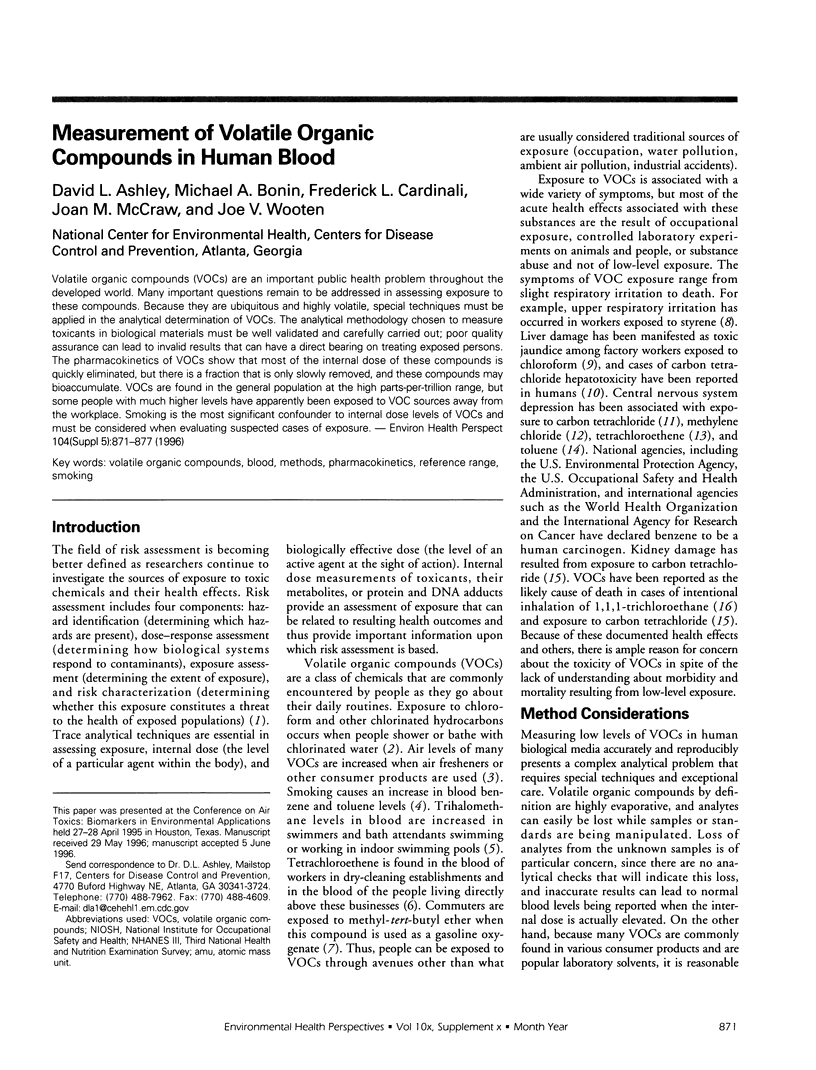
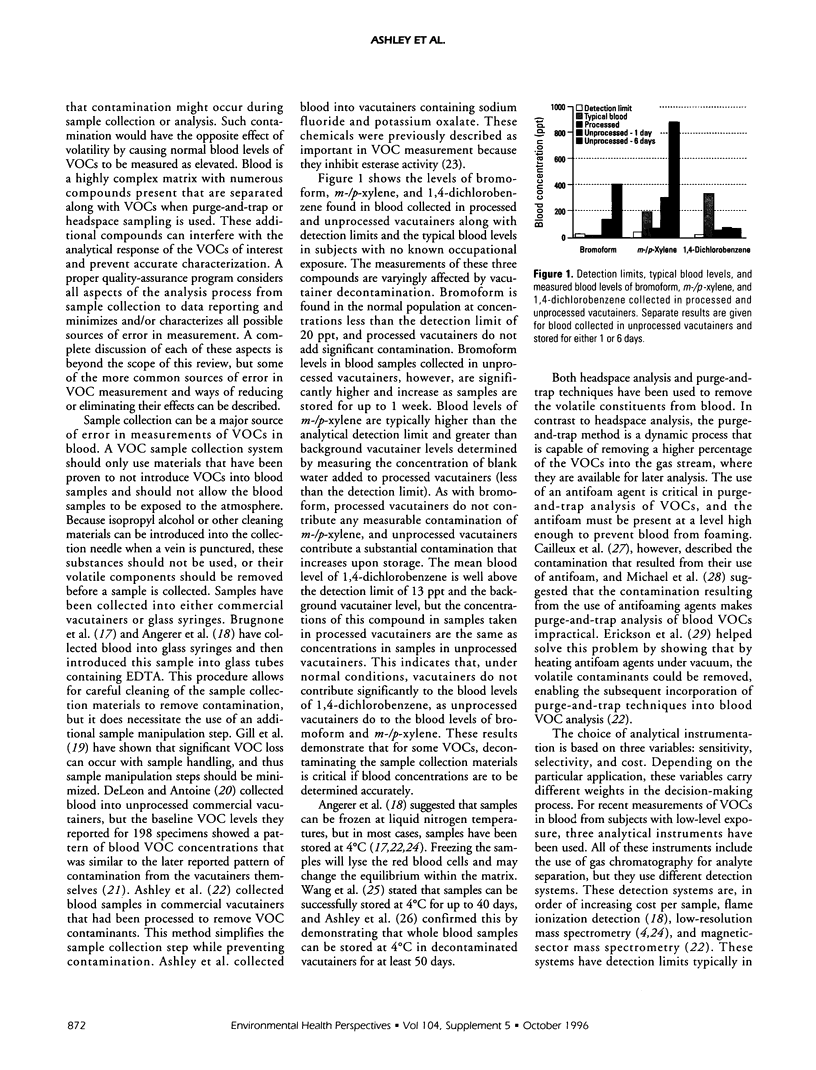
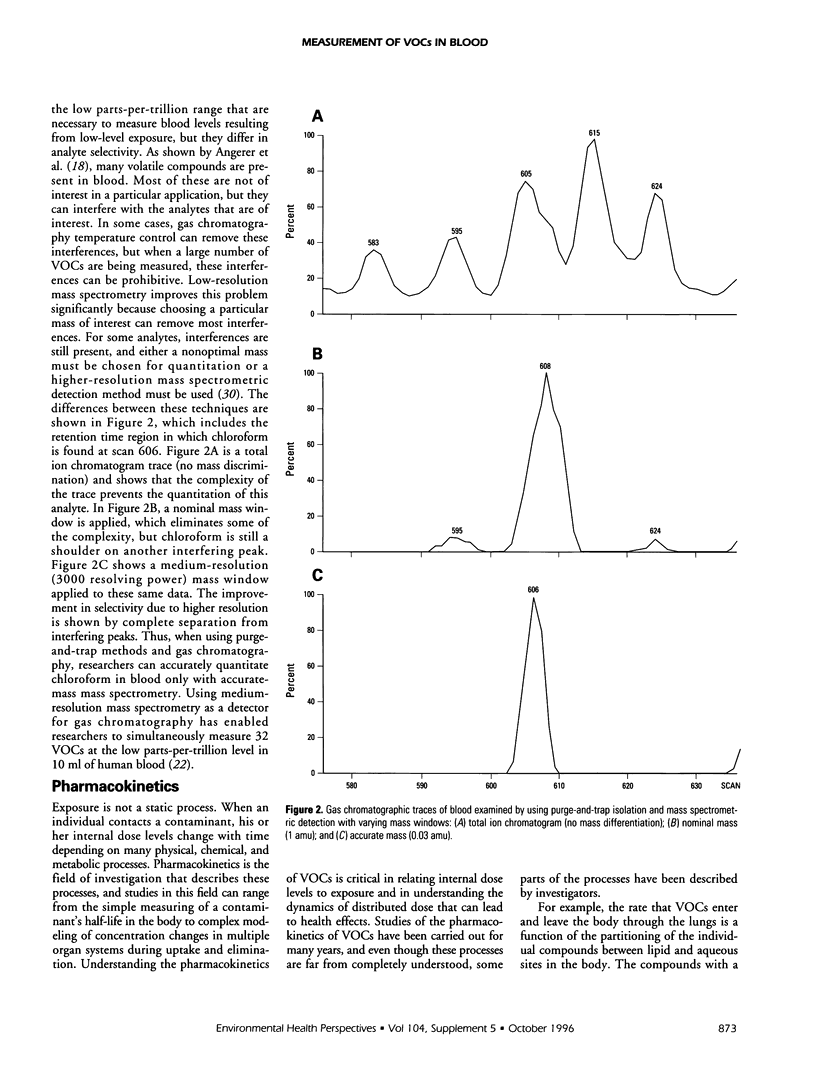
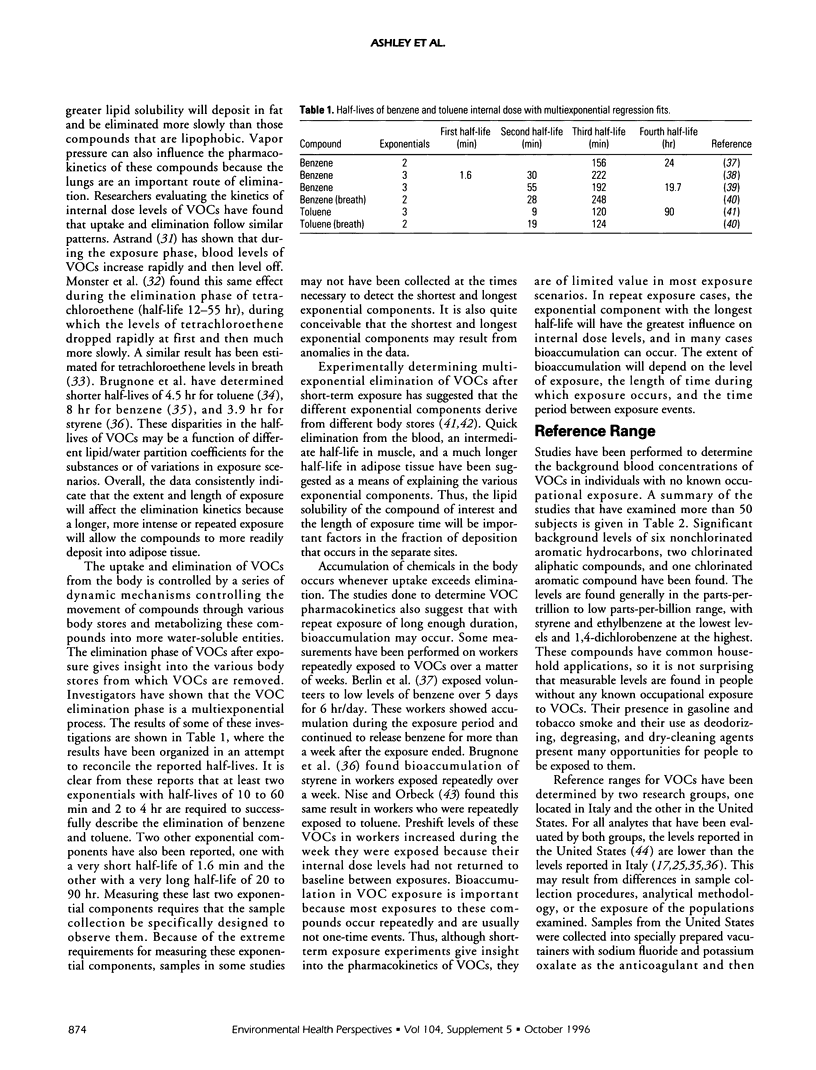
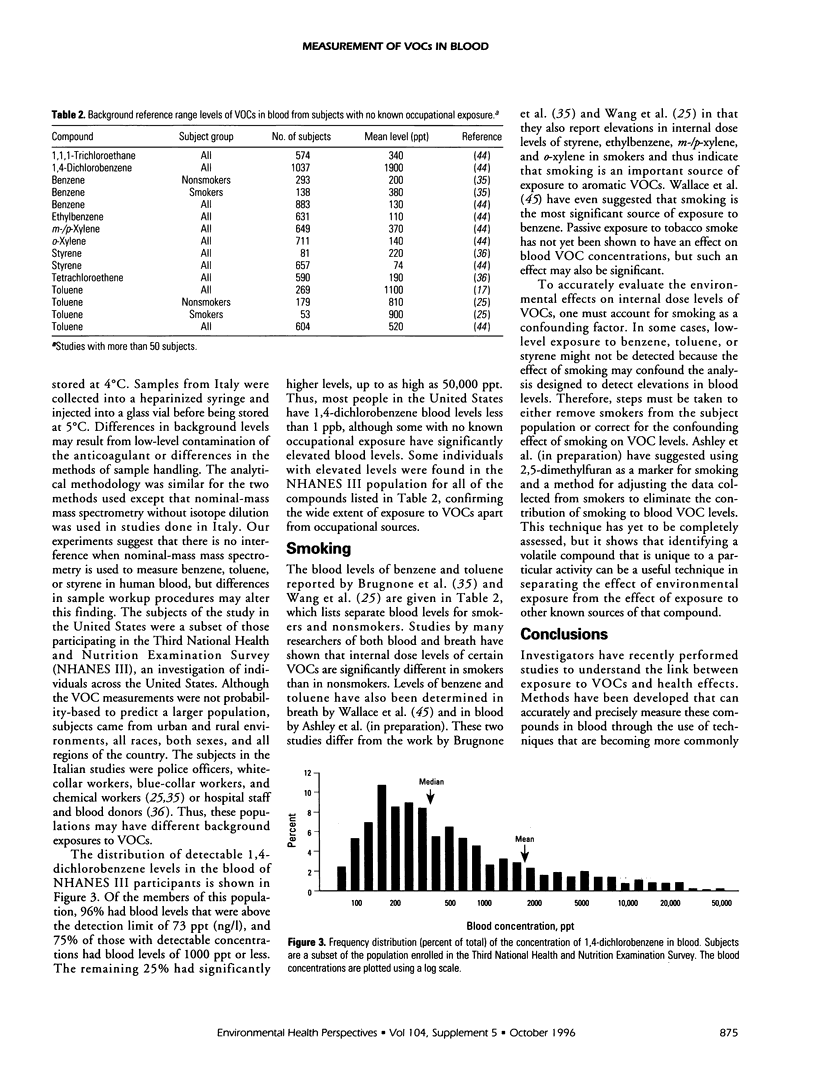
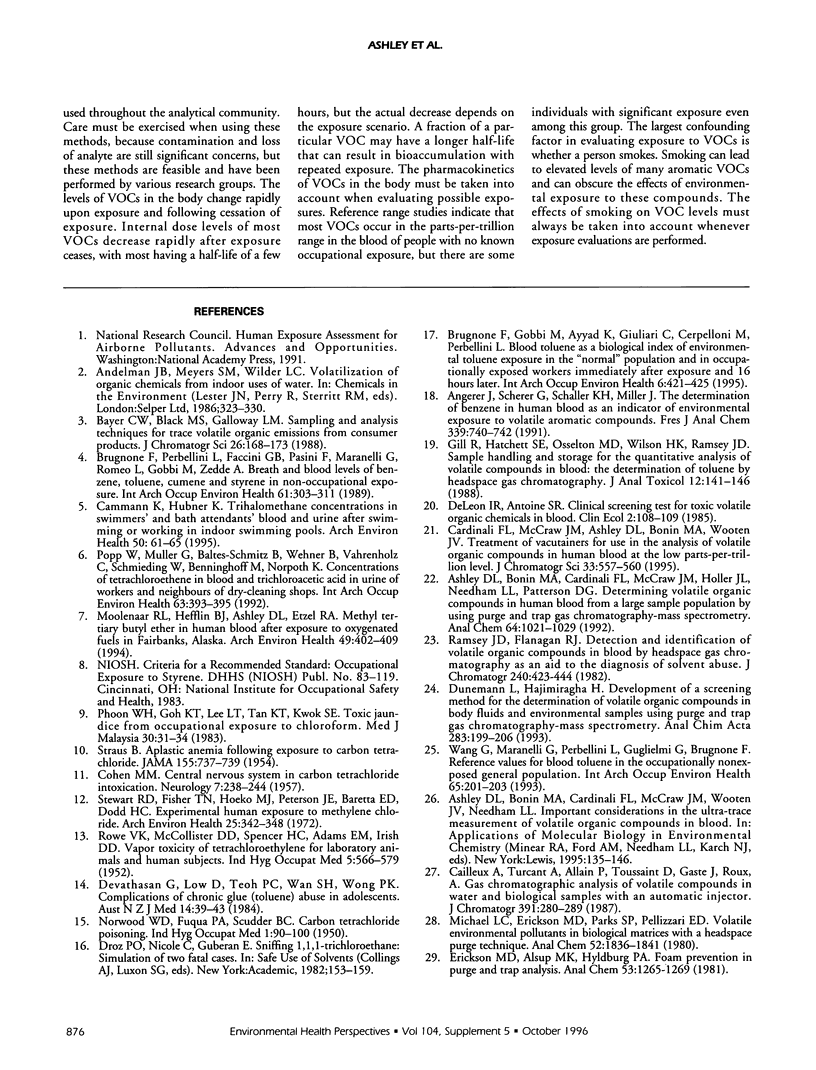

Selected References
These references are in PubMed. This may not be the complete list of references from this article.
- Ashley D. L., Bonin M. A., Cardinali F. L., McCraw J. M., Holler J. S., Needham L. L., Patterson D. G., Jr Determining volatile organic compounds in human blood from a large sample population by using purge and trap gas chromatography/mass spectrometry. Anal Chem. 1992 May 1;64(9):1021–1029. doi: 10.1021/ac00033a011. [DOI] [PubMed] [Google Scholar]
- Ashley D. L., Bonin M. A., Cardinali F. L., McCraw J. M., Wooten J. V. Blood concentrations of volatile organic compounds in a nonoccupationally exposed US population and in groups with suspected exposure. Clin Chem. 1994 Jul;40(7 Pt 2):1401–1404. [PubMed] [Google Scholar]
- Astrand I. Uptake of solvents in the blood and tissues of man. A review. Scand J Work Environ Health. 1975 Dec;1(4):199–218. [PubMed] [Google Scholar]
- Bayer C. W., Black M. S., Galloway L. M. Sampling and analysis techniques for trace volatile organic emissions from consumer products. J Chromatogr Sci. 1988 Apr;26(4):168–173. doi: 10.1093/chromsci/26.4.168. [DOI] [PubMed] [Google Scholar]
- Berlin M., Gage J. C., Gullberg B., Holm S., Knutsson P., Eng C., Tunek A. Breath concentration as an index of the health risk from benzene. Studies on the accumulation and clearance of inhaled benzene. Scand J Work Environ Health. 1980 Jun;6(2):104–111. doi: 10.5271/sjweh.2625. [DOI] [PubMed] [Google Scholar]
- Brugnone F., De Rosa E., Perbellini L., Bartolucci G. B. Toluene concentrations in the blood and alveolar air of workers during the workshift and the morning after. Br J Ind Med. 1986 Jan;43(1):56–61. doi: 10.1136/oem.43.1.56. [DOI] [PMC free article] [PubMed] [Google Scholar]
- Brugnone F., Gobbi M., Ayyad K., Giuliari C., Cerpelloni M., Perbellini L. Blood toluene as a biological index of environmental toluene exposure in the "normal" population and in occupationally exposed workers immediately after exposure and 16 hours later. Int Arch Occup Environ Health. 1995;66(6):421–425. doi: 10.1007/BF00383150. [DOI] [PubMed] [Google Scholar]
- Brugnone F., Perbellini L., Faccini G. B., Pasini F., Maranelli G., Romeo L., Gobbi M., Zedde A. Breath and blood levels of benzene, toluene, cumene and styrene in non-occupational exposure. Int Arch Occup Environ Health. 1989;61(5):303–311. doi: 10.1007/BF00409385. [DOI] [PubMed] [Google Scholar]
- Brugnone F., Perbellini L., Maranelli G., Romeo L., Guglielmi G., Lombardini F. Reference values for blood benzene in the occupationally unexposed general population. Int Arch Occup Environ Health. 1992;64(3):179–184. doi: 10.1007/BF00380906. [DOI] [PubMed] [Google Scholar]
- Brugnone F., Perbellini L., Wang G. Z., Maranelli G., Raineri E., De Rosa E., Saletti C., Soave C., Romeo L. Blood styrene concentrations in a "normal" population and in exposed workers 16 hours after the end of the workshift. Int Arch Occup Environ Health. 1993;65(2):125–130. doi: 10.1007/BF00405731. [DOI] [PubMed] [Google Scholar]
- COHEN M. M. Central nervous system in carbon tetrachloride intoxication. Neurology. 1957 Apr;7(4):238–244. doi: 10.1212/wnl.7.4.238. [DOI] [PubMed] [Google Scholar]
- Cailleux A., Turcant A., Allain P., Toussaint D., Gaste J., Roux A. Gas chromatographic analysis of volatile compounds in water and biological samples with an automatic injector. J Chromatogr. 1987 Mar 27;391(1):280–289. doi: 10.1016/s0021-9673(01)94325-0. [DOI] [PubMed] [Google Scholar]
- Cammann K., Hübner K. Trihalomethane concentrations in swimmers' and bath attendants' blood and urine after swimming or working in indoor swimming pools. Arch Environ Health. 1995 Jan-Feb;50(1):61–65. doi: 10.1080/00039896.1995.9955013. [DOI] [PubMed] [Google Scholar]
- Cardinali F. L., McCraw J. M., Ashley D. L., Bonin M., Wooten J. Treatment of vacutainers for use in the analysis of volatile organic compounds in human blood at the low parts-per-trillion level. J Chromatogr Sci. 1995 Oct;33(10):557–560. doi: 10.1093/chromsci/33.10.557. [DOI] [PubMed] [Google Scholar]
- Devathasan G., Low D., Teoh P. C., Wan S. H., Wong P. K. Complications of chronic glue (toluene) abuse in adolescents. Aust N Z J Med. 1984 Feb;14(1):39–43. doi: 10.1111/j.1445-5994.1984.tb03583.x. [DOI] [PubMed] [Google Scholar]
- Gill R., Hatchett S. E., Osselton M. D., Wilson H. K., Ramsey J. D. Sample handling and storage for the quantitative analysis of volatile compounds in blood: the determination of toluene by headspace gas chromatography. J Anal Toxicol. 1988 May-Jun;12(3):141–146. doi: 10.1093/jat/12.3.141. [DOI] [PubMed] [Google Scholar]
- Michael L. C., Erickson M. D., Parks S. P., Pellizzari E. D. Volatile environmental pollutants in biological matrices with a headspace purge technique. Anal Chem. 1980 Oct;52(12):1836–1841. doi: 10.1021/ac50062a014. [DOI] [PubMed] [Google Scholar]
- Monster A. C., Boersma G., Steenweg H. Kinetics of tetrachloroethylene in volunteers; influence of exposure concentration and work load. Int Arch Occup Environ Health. 1979 Jan 15;42(3-4):303–309. doi: 10.1007/BF00377784. [DOI] [PubMed] [Google Scholar]
- Moolenaar R. L., Hefflin B. J., Ashley D. L., Middaugh J. P., Etzel R. A. Methyl tertiary butyl ether in human blood after exposure to oxygenated fuel in Fairbanks, Alaska. Arch Environ Health. 1994 Sep-Oct;49(5):402–409. doi: 10.1080/00039896.1994.9954993. [DOI] [PubMed] [Google Scholar]
- NORWOOD W. D., FUQUA P. A., SCUDDER B. C. Carbon tetrachloride poisoning; more regulation, more education needed. Arch Ind Hyg Occup Med. 1950 Jan;1(1):90–100. [PubMed] [Google Scholar]
- Nise G., Attewell R., Skerfving S., Orbaek P. Elimination of toluene from venous blood and adipose tissue after occupational exposure. Br J Ind Med. 1989 Jun;46(6):407–411. doi: 10.1136/oem.46.6.407. [DOI] [PMC free article] [PubMed] [Google Scholar]
- Nise G., Orbaek P. Toluene in venous blood during and after work in rotogravure printing. Int Arch Occup Environ Health. 1988;60(1):31–35. doi: 10.1007/BF00409376. [DOI] [PubMed] [Google Scholar]
- Pekari K., Vainiotalo S., Heikkilä P., Palotie A., Luotamo M., Riihimäki V. Biological monitoring of occupational exposure to low levels of benzene. Scand J Work Environ Health. 1992 Oct;18(5):317–322. doi: 10.5271/sjweh.1570. [DOI] [PubMed] [Google Scholar]
- Phoon W. H., Goh K. T., Lee L. T., Tan K. T., Kwok S. F. Toxic jaundice from occupational exposure to chloroform. Med J Malaysia. 1983 Mar;38(1):31–34. [PubMed] [Google Scholar]
- Popp W., Müller G., Baltes-Schmitz B., Wehner B., Vahrenholz C., Schmieding W., Benninghoff M., Norpoth K. Concentrations of tetrachloroethene in blood and trichloroacetic acid in urine in workers and neighbours of dry-cleaning shops. Int Arch Occup Environ Health. 1992;63(6):393–395. doi: 10.1007/BF00386934. [DOI] [PubMed] [Google Scholar]
- ROWE V. K., McCOLLISTER D. D., SPENCER H. C., ADAMS E. M., IRISH D. D. Vapor toxicity of tetrachloroethylene for laboratory animals and human subjects. AMA Arch Ind Hyg Occup Med. 1952 Jun;5(6):566–579. [PubMed] [Google Scholar]
- Ramsey J. D., Flanagan R. J. Detection and identification of volatile organic compounds in blood by headspace gas chromatography as an aid to the diagnosis of solvent abuse. J Chromatogr. 1982 May 21;240(2):423–444. doi: 10.1016/s0021-9673(00)99622-5. [DOI] [PubMed] [Google Scholar]
- Raymer J. H., Pellizzari E. D., Thomas K. W., Cooper S. D. Elimination of volatile organic compounds in breath after exposure to occupational and environmental microenvironments. J Expo Anal Environ Epidemiol. 1991 Oct;1(4):439–451. [PubMed] [Google Scholar]
- STRAUS B. Aplastic anemia following exposure to carbon tetrachloride. J Am Med Assoc. 1954 Jun 19;155(8):737–739. doi: 10.1001/jama.1954.73690260001008. [DOI] [PubMed] [Google Scholar]
- Sato A., Nakajima T., Fujiwara Y., Hirosawa K. Pharmacokinetics of benzene and toluene. Int Arch Arbeitsmed. 1974;33(3):169–182. doi: 10.1007/BF00538916. [DOI] [PubMed] [Google Scholar]
- Stewart R. D., Fisher T. N., Hosko M. J., Peterson J. E., Baretta E. D., Dodd H. C. Experimental human exposure to methylene chloride. Arch Environ Health. 1972 Nov;25(5):342–348. doi: 10.1080/00039896.1972.10666184. [DOI] [PubMed] [Google Scholar]
- Wallace L. A., Pellizzari E. D., Hartwell T. D., Sparacino C., Whitmore R., Sheldon L., Zelon H., Perritt R. The TEAM (Total Exposure Assessment Methodology) Study: personal exposures to toxic substances in air, drinking water, and breath of 400 residents of New Jersey, North Carolina, and North Dakota. Environ Res. 1987 Aug;43(2):290–307. doi: 10.1016/s0013-9351(87)80030-0. [DOI] [PubMed] [Google Scholar]
- Wallace L., Pellizzari E., Gordon S. A linear model relating breath concentrations to environmental exposures: application to a chamber study of four volunteers exposed to volatile organic chemicals. J Expo Anal Environ Epidemiol. 1993 Jan-Mar;3(1):75–102. [PubMed] [Google Scholar]
- Wallace L., Pellizzari E., Hartwell T. D., Perritt R., Ziegenfus R. Exposures to benzene and other volatile compounds from active and passive smoking. Arch Environ Health. 1987 Sep-Oct;42(5):272–279. doi: 10.1080/00039896.1987.9935820. [DOI] [PubMed] [Google Scholar]
- Wang G., Maranelli G., Perbellini L., Guglielmi G., Brugnone F. Reference values for blood toluene in the occupationally nonexposed general population. Int Arch Occup Environ Health. 1993;65(3):201–203. doi: 10.1007/BF00381156. [DOI] [PubMed] [Google Scholar]


